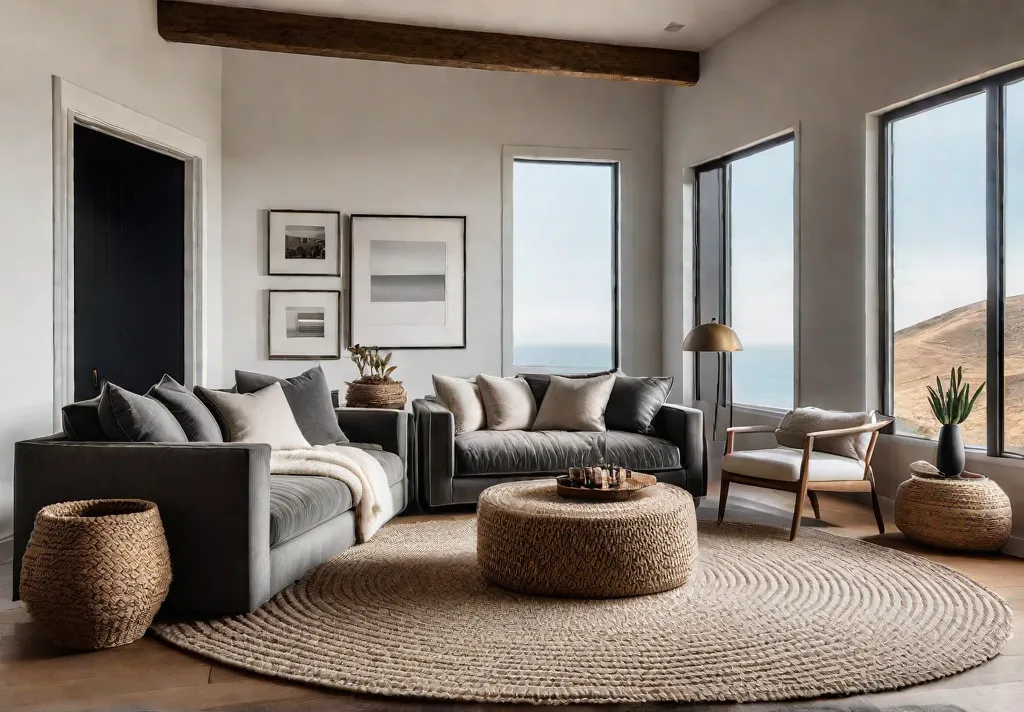Have you ever stepped into a room and immediately felt a sense of warmth and comfort wash over you? That's the magic of texture—a design element that can transform a space from merely functional to an inviting, cozy haven. Imagine sinking into a plush velvet sofa, feeling the soft nap of a textured rug beneath your feet, and being surrounded by layers of tactile beauty that beckon you to linger, relax, and embrace the moment.
In interior design, texture plays a crucial role in creating depth, visual interest, and an irresistible allure that draws you in. Whether it's the nubby warmth of a boucle throw or the sleek coolness of a hammered metal accent, each textural element adds a unique dimension to the overall ambiance. When expertly combined, these textures weave a tapestry of comfort and style that elevates your living room into a true sanctuary.

So, let's embark on a journey through the art of textural design. We'll explore ten captivating ways to infuse your living room with tactile bliss. From the power of plush to the interplay of contrasting textures, we'll unravel the secrets to creating a space that looks stunning and feels like a warm embrace.
The Power of Plush: Embracing Sumptuous Softness
Few textures can rival the allure of plush fabrics when it comes to creating a cozy living room. Imagine sinking into a sumptuous velvet sofa, enveloped in its rich, silky nap, or wrapping yourself in a chunky knit throw that feels like a comforting hug. These luxurious textiles can transform a space from merely functional to an inviting, tactile oasis.
The Allure of Touchable Textures
There's something inherently comforting about running your fingers over a soft, plush surface. Whether it's the velvety smoothness of chenille or the nubby warmth of boucle, these fabrics invite you to linger, relax, and indulge in their tactile delights. In a world that often feels cold and impersonal, the power of touchable textures lies in their ability to evoke a sense of coziness and nostalgia, reminding us of the simple pleasures of snuggling up with a beloved blanket or sinking into a cozy armchair.
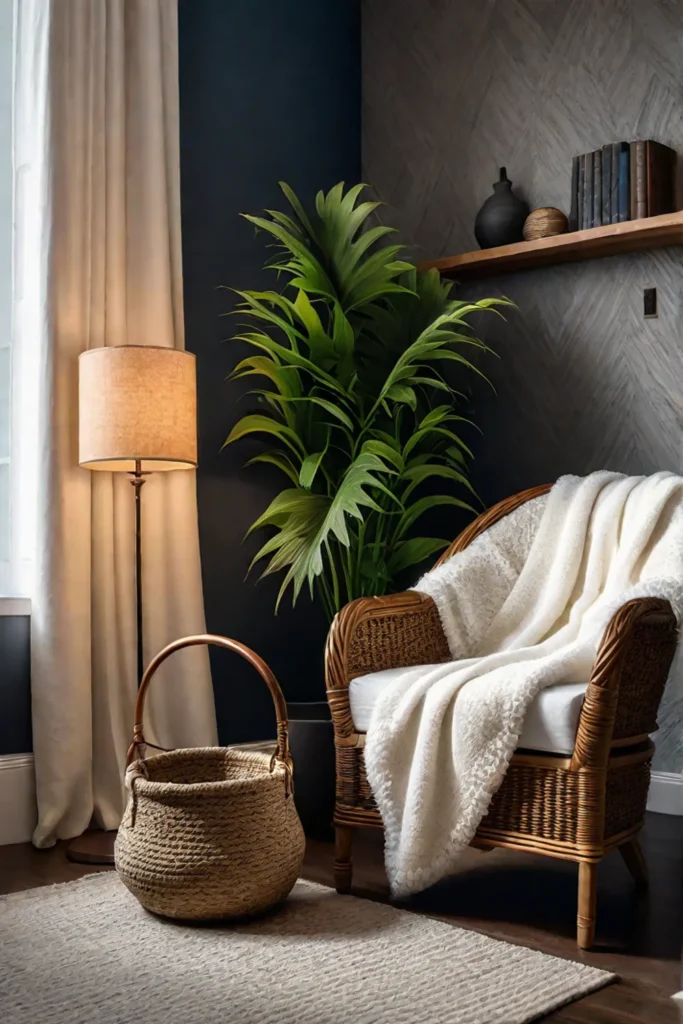
Incorporating Plush Seating and Upholstery
When creating a cozy living room, plush seating and upholstery should be at the forefront of your design. Consider a deep, enveloping velvet sofa as the centerpiece of the room, beckoning you to curl up with a good book or a warm mug of tea. Alternatively, a cozy armchair upholstered in a sumptuous chenille fabric can become your retreat, a place to unwind after a long day.
Layering Throw Blankets and Pillows for a Cozy Cocoon
Don't stop at the furniture to truly embrace the power of plush. Layer your space with abundant throw blankets and pillows in complementary textures and patterns. A chunky knit blanket draped over the arm of your sofa or a collection of boucle pillows scattered across your seating area can elevate the cozy factor to new heights. Not only do these textural accents add visual interest, but they also invite you to snuggle up and create your comfortable cocoon.
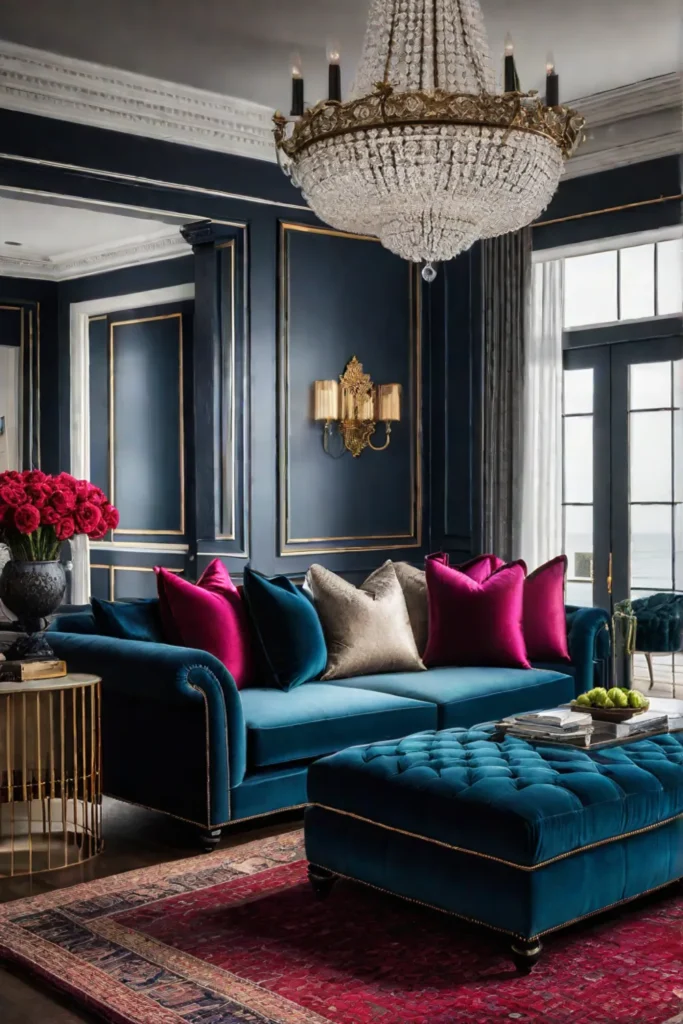
With plush fabrics as the foundation, your living room will exude a sense of warmth and comfort that is simply irresistible. Whether you're curling up with a good book or hosting a cozy gathering with friends, the power of plush will envelop you in a tactile embrace, making every moment spent in your living room a true delight.
Contrasting Textures: A Symphony of Tactile Intrigue
While the allure of plush fabrics is undeniable, introducing contrasting textures into your living room design can create a captivating symphony of tactile intrigue. By juxtaposing smooth and rough, hard and soft, you'll add depth, visual interest, and a dynamic energy that keeps the eye and the senses engaged.
The Interplay of Contrasting Textures
Imagine the sleek coolness of a leather sofa paired with the warmth of a chunky, woven area rug. Or a smooth, polished coffee table contrasted with the natural texture of a rugged, reclaimed wood accent wall. These opposing elements create a delightful tension that invites exploration and appreciation of the varying tactile qualities.
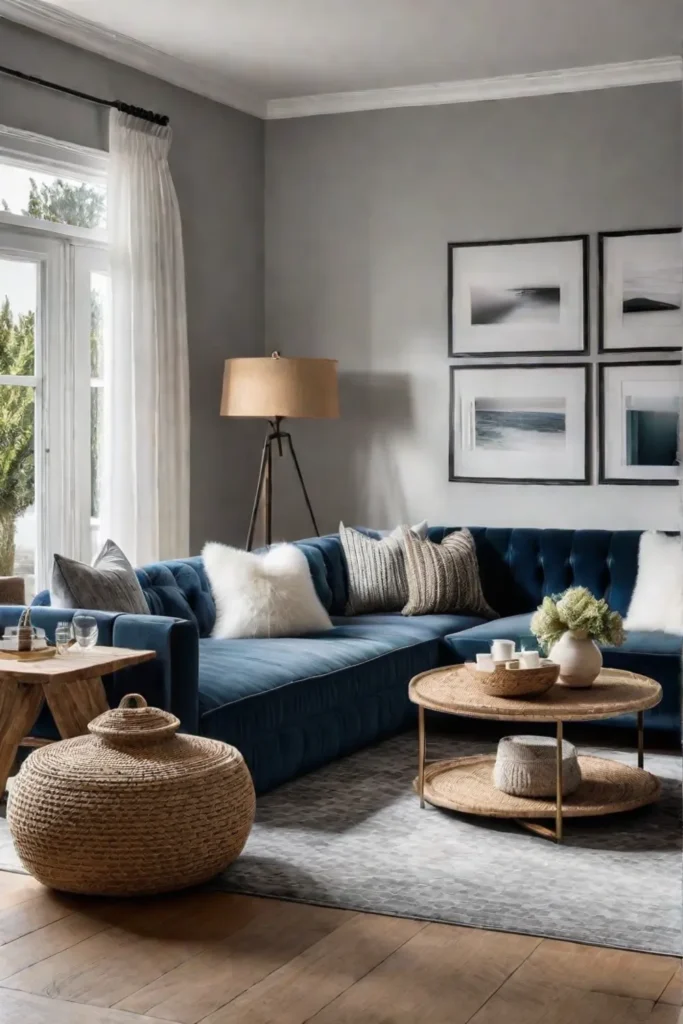
Moreover, contrasting textures can evoke a range of emotions and associations. Rough, natural textures like stone or wood can lend a sense of earthy authenticity and grounding, while smooth, sleek surfaces exude a more modern, polished aesthetic. By skillfully blending these contrasting elements, you can create a visually striking and emotionally resonant space.
Pairing Sleek and Rustic Elements
One of the most captivating ways to incorporate contrasting textures is by pairing sleek, contemporary pieces with rustic, organic elements. Consider a plush, tufted sofa in a rich, velvety fabric juxtaposed with a distressed, reclaimed wood coffee table. Or a sleek, metallic floor lamp standing in contrast to a hand-woven, textured area rug. These unexpected combinations add visual interest and create a sense of depth and character that elevates the overall design.
Using Texture to Create Visual Focal Points
Texture can also be a powerful tool to draw the eye and create focal points within your living room. A textured accent wall, whether a woven tapestry or a statement-making stone feature, can become the space's centerpiece, demanding attention and setting the tone for the entire room.
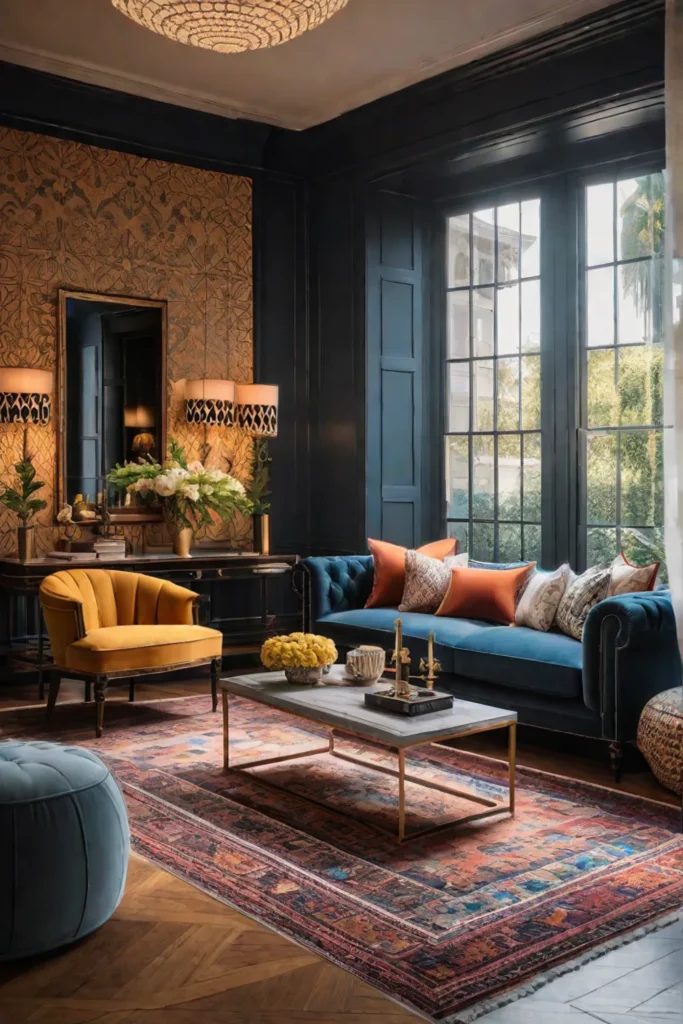
By strategically placing textural accents, you can guide the viewer's gaze and create a visually dynamic environment that engages the senses. A hammered metal side table or a carved wooden sculpture can be eye-catching accents, adding depth and dimension to your design.
Embracing contrasting textures is an art form that requires a delicate balance and a keen eye for harmonious juxtaposition. When executed thoughtfully, contrasting textures can transform your living room into a multi-sensory experience, inviting you to explore, touch, and appreciate the rich tapestry of tactile elements surrounding you.
Layering Textiles: A Cozy Embrace of Patterns and Hues
The art of layering textiles is a true game-changer in creating a cozy living room. By combining patterns, colors, and textures, you can craft a space that feels visually captivating and physically comforting, enveloping you in a warm embrace of tactile beauty.
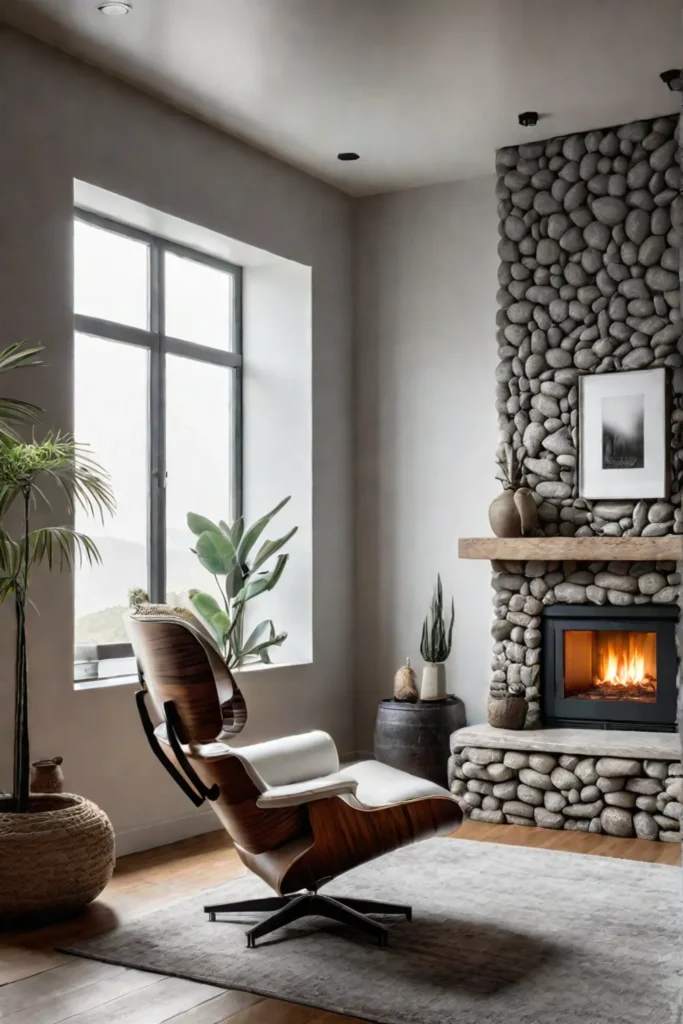
The Benefits of Textile Layering
Layering textiles is more than just a design trend; it's a practical approach that offers numerous benefits. For starters, it helps absorb sound, creating a more intimate atmosphere that feels cocooned and serene. Additionally, the human brain is wired to find comfort in nested, cocooned spaces, making textile layering a natural choice for cultivating a sense of coziness.
Combining Patterns, Colors, and Textures
The true magic of textile layering lies in the artful combination of patterns, colors, and textures. Imagine a rich, jewel-toned velvet sofa adorned with a collection of throw pillows in complementary hues and patterns, each offering a unique textural delight. A chunky knit blanket draped over the arm of the sofa adds another layer of warmth and visual interest, while a patterned area rug anchors the space and ties the various elements together.
When layering textiles, it's essential to balance cohesion and contrast. While complementary patterns and colors create a sense of harmony, introducing unexpected textures and subtle clashes can add depth and intrigue to the overall design.

Achieving a Cohesive Yet Dynamic Look
One of the challenges of textile layering is achieving a cohesive yet dynamic look that feels intentional and well-curated. To accomplish this, start by selecting a color palette that resonates with you and reflects the desired ambiance of your living room. From there, introduce various patterns and textures that complement and build upon one another, creating a visually rich tapestry that invites exploration.
Additionally, consider the scale and proportion of the textiles you choose. A large, bold pattern on a statement piece like an area rug can be balanced by smaller, more subtle patterns on throw pillows or blankets. This scale interplay adds visual interest and prevents the space from feeling overwhelming or disjointed.
By embracing the art of textile layering, you'll create a cozy living room that feels inviting and visually captivating and cultivate a space that truly reflects your style and taste. Each textile layer adds depth, character, and a touch of warmth, transforming your living room into a cozy haven you'll never want to leave.
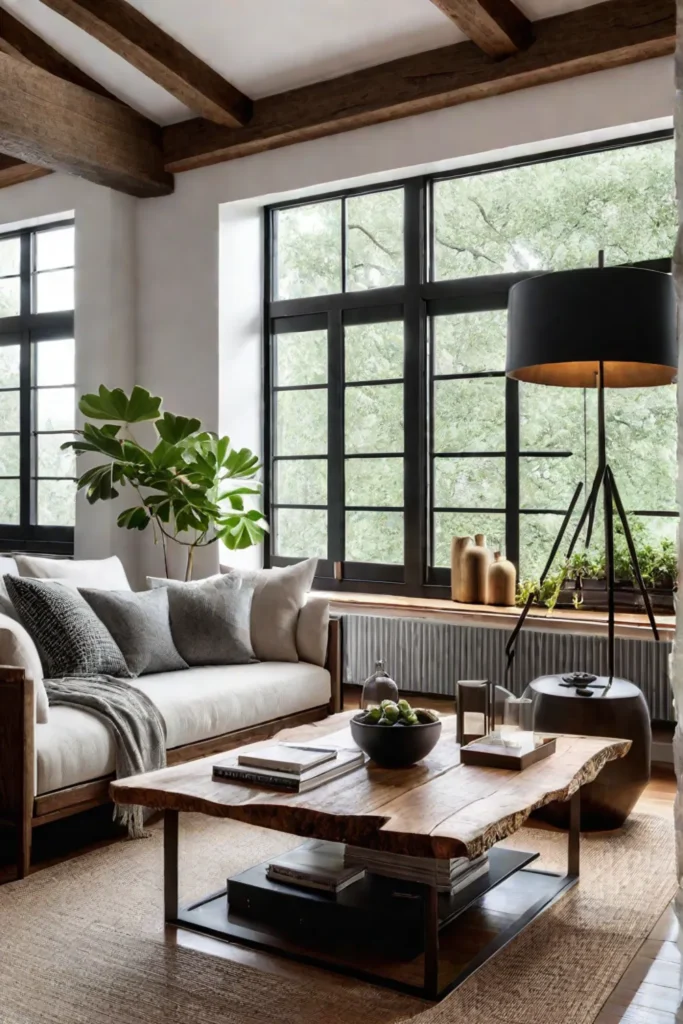
Accentuating with Texture: Highlighting Design Elements
While textural elements can serve as the foundation for a cozy living room design, they can also be used as accents to highlight key features and elevate the overall aesthetic. By strategically incorporating textural accents, you can create visual interest, draw the eye to focal points, and add depth and dimension to your space.
Incorporating Textural Accents
Textural accents come in many forms, from woven pendant lights and textured wall hangings to carved wood or hammered metal side tables. These elements add tactile appeal and serve as eye-catching focal points that demand attention and appreciation.
Imagine a woven pendant light casting a warm, diffused glow over your living room, its intricate textures casting captivating shadows on the walls. Or a macramé wall hanging serving as a striking backdrop for your seating area, its intricate knots, and patterns creating a sense of depth and movement.
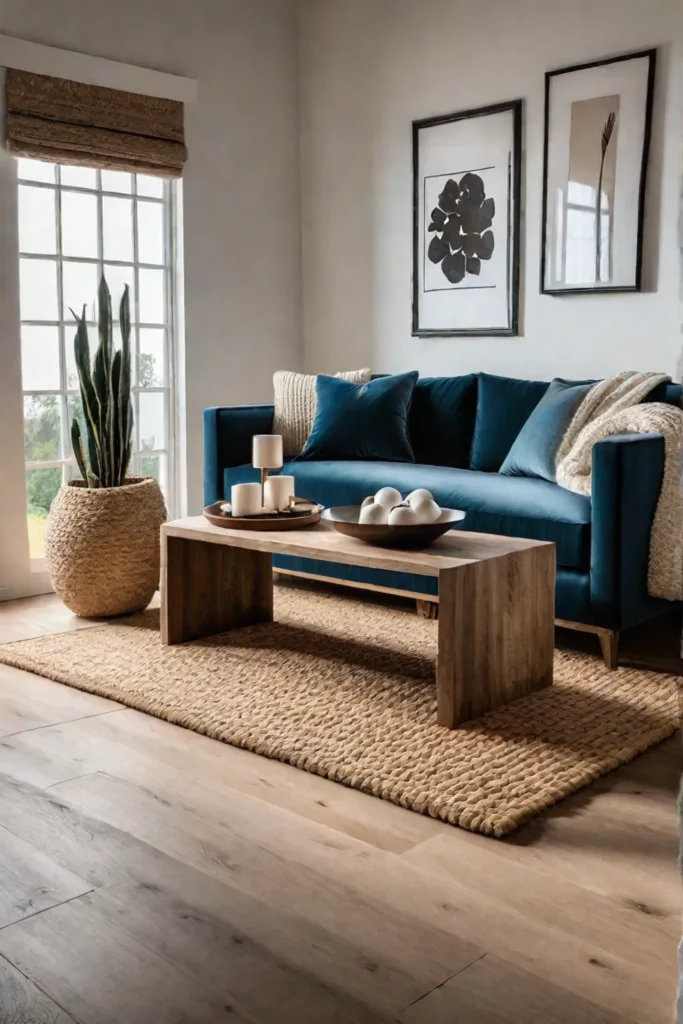
Using Texture to Draw the Eye
Certain textures have an innate ability to capture the eye and create visual interest. The nubby texture of a boucle throw draped over the arm of a sofa or the shimmering sheen of a velvet accent chair can serve as subtle yet captivating focal points within your living room design.
By strategically placing these textural elements, you can guide the viewer's gaze and create a visually dynamic environment that engages the senses. A carved wood coffee table can become the centerpiece of your seating arrangement, while a hammered metal side table can add a touch of industrial chic to a cozy corner.
Balancing Textural Elements
While textural accents can add depth and interest to your living room design, striking a balance is essential to avoid overwhelming the space. Too many competing textures can create a cluttered and chaotic atmosphere, detracting from the cozy ambiance you're trying to cultivate.
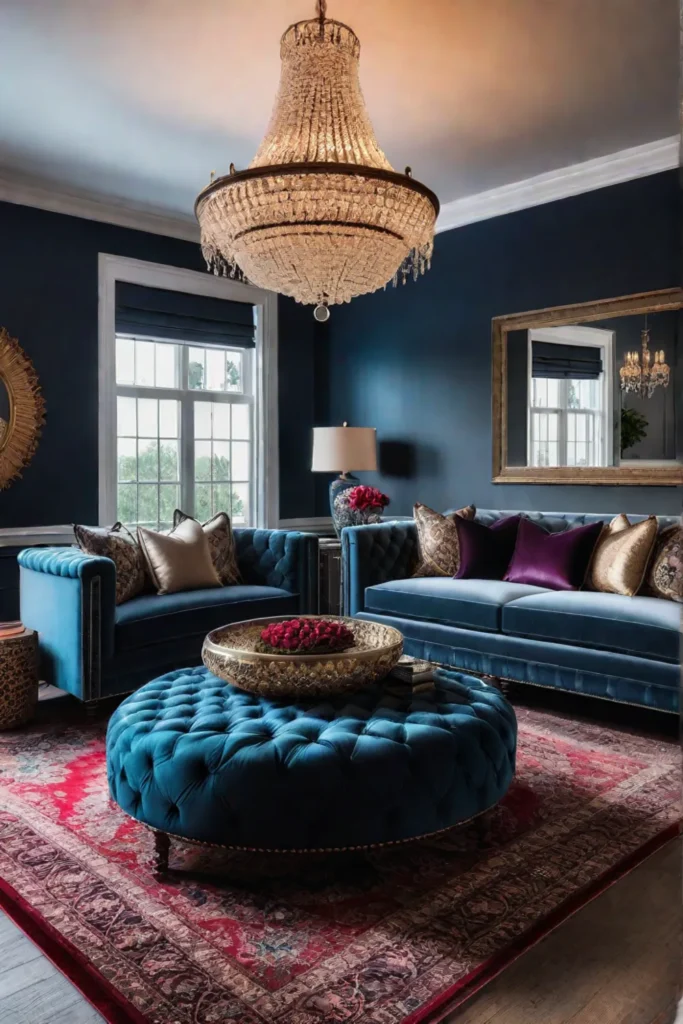
Consider the scale and proportion of your textural accents to achieve a harmonious balance. A large, statement-making piece, like a textured accent wall, can be balanced by smaller, more subtle textural elements, such as a woven throw or a textured ceramic vase.
By strategically incorporating textural accents and balancing them with the overall design, you can create a living room that is visually engaging, inviting, and cohesive. Each textural element becomes a carefully curated puzzle piece, adding depth, dimension, and a touch of tactile intrigue to your cozy haven.
Color Palettes and Texture: A Harmonious Interplay
In cozy living room design, color and texture are inextricably intertwined, each element influencing and enhancing the other. By thoughtfully combining color palettes with textural elements, you can create a harmonious ambiance that looks stunning and feels inviting and comforting.

The Relationship Between Color and Texture
Color and texture have a symbiotic relationship, with each element playing a crucial role in shaping a space's overall aesthetic and mood. Warm, earthy color palettes often pair beautifully with natural, tactile textures like woven fabrics, rough-hewn wood, and organic materials. These combinations evoke a sense of grounding and connection to nature, creating a cozy and inviting atmosphere.
Conversely, cool, muted tones can lend a serene and calming vibe when combined with soft, plush textiles like velvet or chenille. These pairings create a sense of tranquility and relaxation, perfect for a living room designed as a sanctuary from the hustle and bustle of daily life.
Using Color to Enhance Textural Elements
Color can be a powerful tool to enhance and complement the textural elements in your living room design. Imagine a rich, jewel-toned velvet sofa paired with a textured area rug in complementary hues and throw pillows in contrasting patterns and textures. The interplay of colors and textures creates a visually striking and inviting focal point, drawing the eye and inviting you to sink into the plush embrace of the seating arrangement.

Alternatively, a neutral color scheme can serve as a versatile backdrop, allowing the textural elements to take center stage. A crisp white sofa can be elevated by adding a chunky knit throw and a collection of textured pillows in beige, taupe, and gray shades. This subtle palette allows the textures to shine, creating a cozy and inviting atmosphere without overwhelming the senses.
Achieving a Harmonious Color and Texture Balance
Achieving a harmonious balance between color and texture is an art form. It requires a keen eye for complementary hues and a thoughtful approach to layering and combining various textural elements.
One effective strategy is to start with a neutral base and introduce pops of color through accent pieces like vases, artwork, or decorative accessories. This allows you to experiment with different color combinations and textural elements without overwhelming the space.
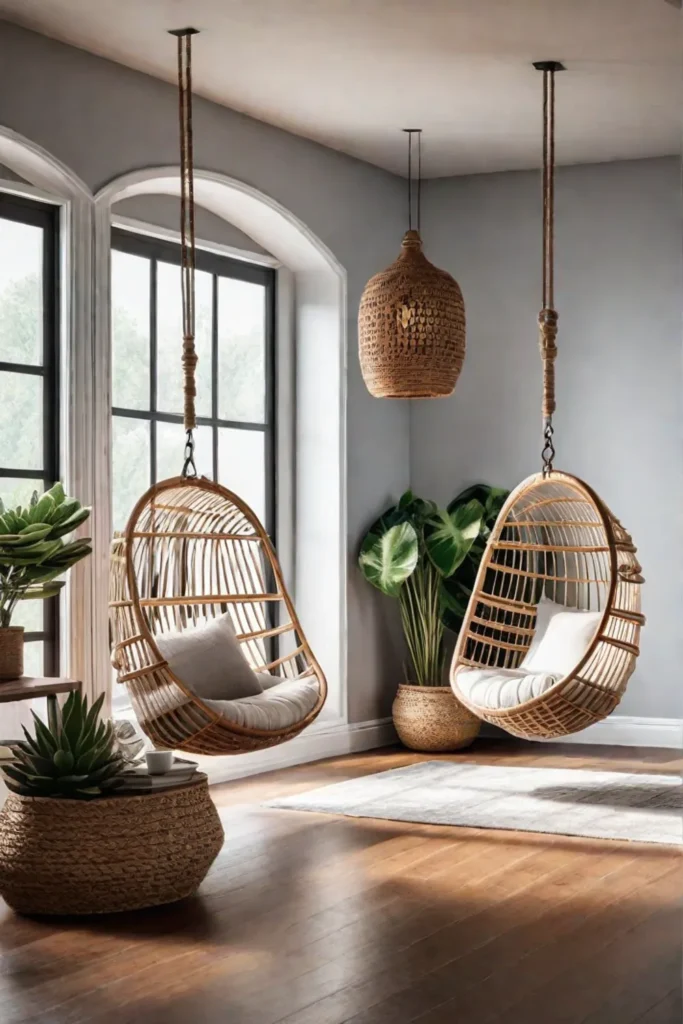
Another approach is to select a cohesive color palette and then introduce varying textures within that palette. For example, a warm, terracotta-hued living room could feature a velvet sofa, a woven area rug, and a collection of textured throw pillows in complementary shades of rust, ochre, and burnt orange.
By carefully curating the interplay between color and texture, you can create a living room that is both visually stunning and comfortingly cozy. Each element works in harmony, inviting you to sink into the space's embrace and appreciate the rich tapestry of tactile delights that surround you.
Lighting and Texture: Illuminating Tactile Delights
In creating a cozy living room, lighting highlights and accentuates the textural elements that contribute to the overall ambiance. By thoughtfully considering the interplay between lighting and texture, you can transform your space into a warm, inviting oasis that captivates the senses and beckons you to linger.

The Role of Lighting in Enhancing Texture
Lighting can reveal the depth and dimension of textural surfaces, bringing them to life and creating a sense of depth and movement within your living room. Soft, diffused lighting can accentuate the nap of a plush velvet sofa or the intricate weave of a textured area rug, casting subtle shadows and highlights that add depth and intrigue.
Additionally, certain lighting fixtures can become textural elements in their own right. A woven pendant light or a metallic sconce with intricate details can add a touch of tactile interest to your space, casting captivating patterns of light and shadow that dance across the walls and surfaces.
Using Lighting to Create a Warm, Intimate Atmosphere
Beyond enhancing textural elements, lighting plays a crucial role in setting the mood and ambiance of your living room. Dimmable lamps and sconces can create a warm, cozy glow that envelops the space, inviting you to relax and unwind after a long day.
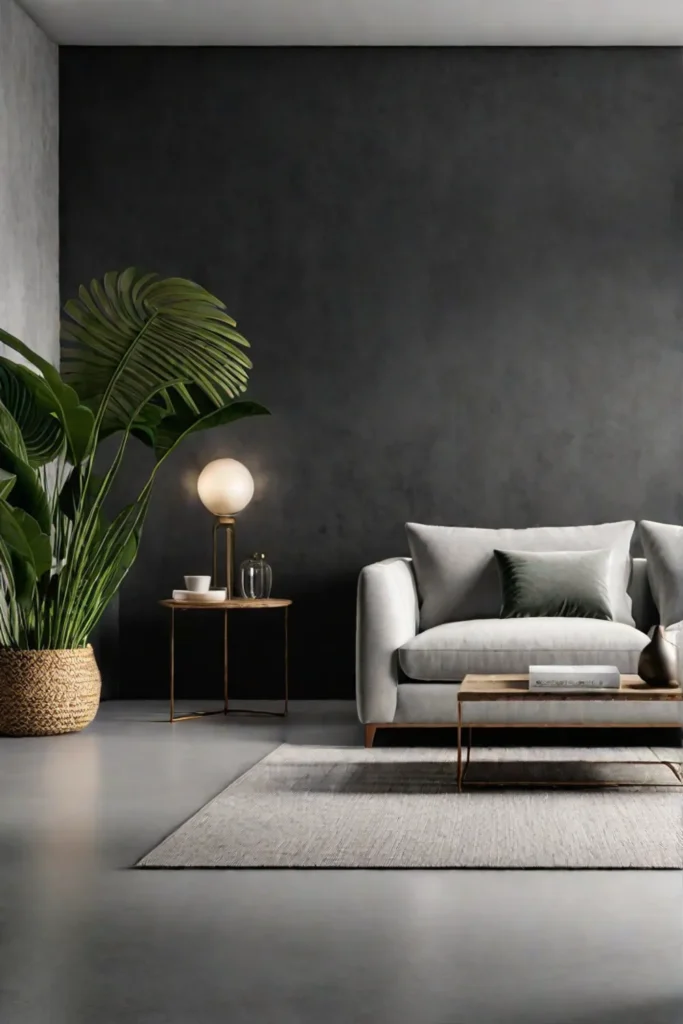
Strategically placing floor or table lamps can also help highlight specific textural features or create intimate vignettes within your living room. A warm, ambient light can illuminate a cozy reading nook, creating a cocoon-like atmosphere that beckons you to curl up with a good book and lose yourself in the tactile delights surrounding you.
Incorporating Textural Lighting Elements
While lighting can enhance the textural elements in your living room, it can also serve as a textural element in its own right. Incorporating textural lighting fixtures, such as woven pendants or metallic sconces, can add depth and visual interest to your space.
Imagine a woven pendant light casting intricate patterns of light and shadow across the room, creating a sense of movement and depth that captivates the eye. Or a hammered metal sconce with complicated details that casts a warm, ambient glow, adding a touch of industrial chic to your cozy living room.
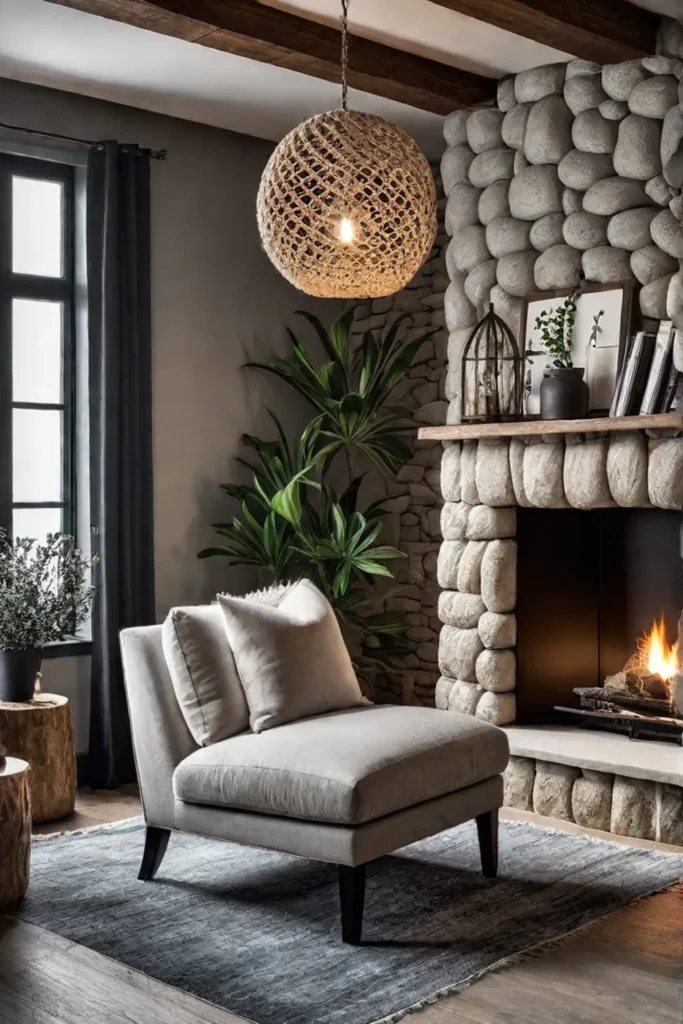
By thoughtfully considering the interplay between lighting and texture, you can create a multi-sensory experience that looks stunning and feels inviting and comforting. Each element works harmoniously, creating a cozy haven that embraces you with its warm, tactile embrace.
Furniture and Texture: Crafting Cozy Vignettes
When selecting upholstered furniture for your cozy living room, prioritize pieces that offer comfort and style. A deep, plush sofa upholstered in a soft, touchable fabric like velvet or chenille can become the centerpiece of your space, inviting you to sink into its embrace and unwind1. Pair it with a cozy armchair or loveseat in a complementary texture, such as a nubby boucle or a smooth, buttery leather, to create a seating arrangement that feels visually appealing and incredibly comfortable.
Incorporating Rustic and Distressed Elements
Consider incorporating rustic and distressed furniture elements to add depth and character to your cozy living room. A reclaimed wood coffee table with a weathered, textured surface can serve as a striking contrast to the softness of your upholstered pieces. Similarly, a distressed metal side table or a vintage trunk repurposed as a storage ottoman can introduce a sense of history and charm to your space, adding to the overall cozy ambiance.
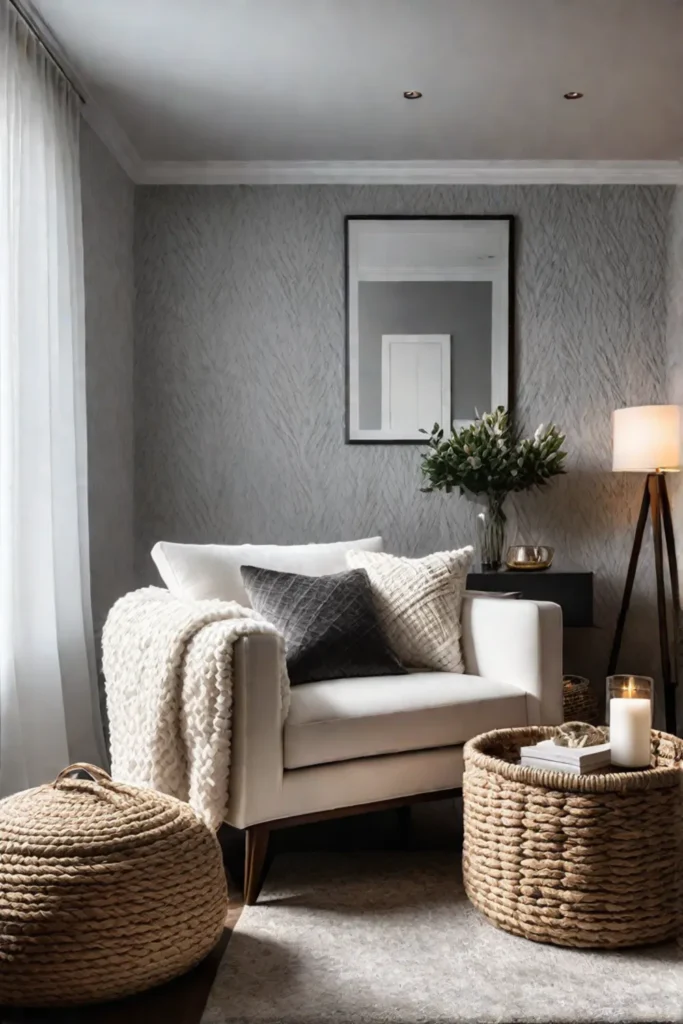
Layering Textiles on Furniture
Layering textiles on your furniture is an effective way to enhance the cozy factor of your living room. Drape a chunky knit throw over the back of your sofa or arrange a collection of plush, textured pillows on your armchairs. These layers of textiles not only add visual interest and depth to your furniture but provide an irresistible invitation to snuggle up and get comfortable.
Creating Cozy Vignettes
Furniture placement and arrangement are crucial in crafting cozy vignettes in your living room. Consider creating intimate seating areas that encourage conversation and relaxation, such as armchairs around a small side table or a loveseat nestled next to a floor lamp and a bookshelf. These vignettes become inviting nooks where you can curl up with a good book, enjoy a warm beverage, or engage in heartfelt conversations with loved ones.
Texture in Unexpected Places
When incorporating texture into your living room, don't limit yourself to traditional furniture. Consider adding textural elements in unexpected places, such as a woven wall above your sofa or a plush, tufted ottoman that doubles as a coffee table1. These unconventional touches of texture add visual interest and contribute to the overall cozy atmosphere of your space.
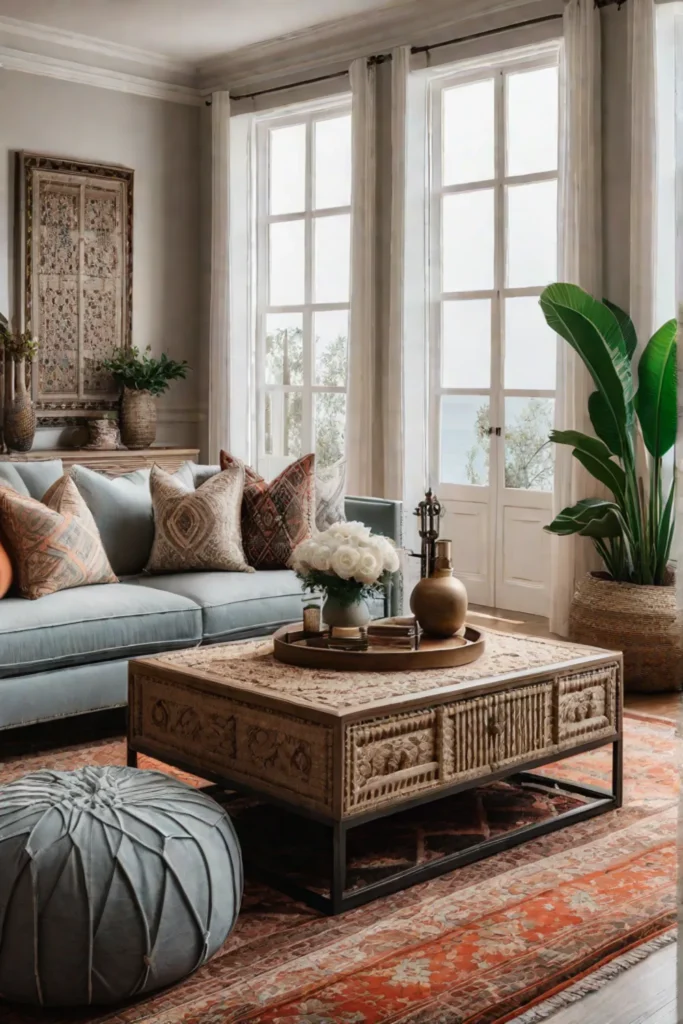
Conclusion
Creating a cozy living room is an art form that involves a thoughtful interplay of textures, colors, lighting, and furniture. By embracing the power of plush fabrics, contrasting textures, layered textiles, and strategic accents, you can transform your living room into an inviting sanctuary that envelops you in warmth and comfort. Remember, the details are the key to achieving a truly cozy space. From the soft nap of a velvet sofa to the intricate weave of a textured rug, each element contributes to the overall tactile experience.
By carefully curating these elements and arranging them in a visually appealing and emotionally resonant way, you can create a living room that becomes a true haven – a place where you can relax, recharge, and find solace from the outside world. So embrace the transformative power of texture, and let your living room become a cozy oasis that reflects your style and invites you to linger in its warm, inviting embrace.
